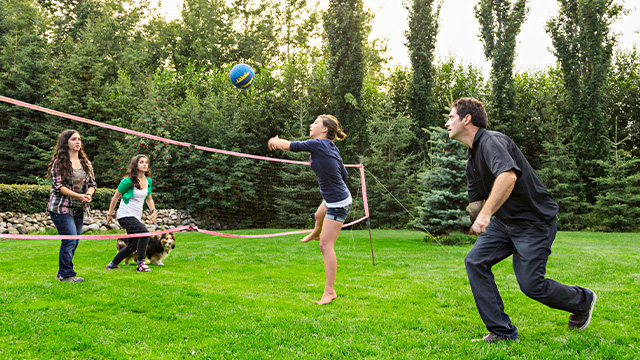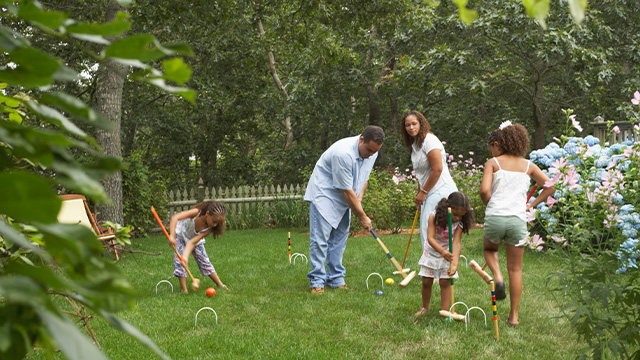Yard Games: The Home Field Advantage
Discover four ways to transform your backyard into a personal field of dreams.
In case you need a reminder, you can do whatever you want with your backyard. And if you want to build a court or field that draws family and friends into long, sweaty afternoons of cutthroat competition, by all means, go for it.
Having a game-ready yard may even do you some good: Studies indicate that people who spend more time under an open sky sleep better and view the world with more optimism. They also have a lower risk of chronic disease, and they’re less likely to experience anxiety or depression.
But no one plays anything for the health benefits. Games are all about fun, even when that fun comes from perfecting a penalty kick or crushing your loved one in a hotly contested croquet match.
Shop This Story
Ruler Measurement Set
SHOP NOWTow Broadcast Spreader
SHOP NOWZ530M ZTrak™ Mower with 48-in. Deck
SHOP NOWPremium Black Stripe Lawn Chair
SHOP NOWPlaid Fleece Blanket with Waterproof Backing
SHOP NOWSmokey Mountain Cooker Smoker
SHOP NOWCharcoal Grill (HR-CGS225)
SHOP NOWLay Flat Garden Hose 100 Feet
SHOP NOWFire Pit
SHOP NOWCooler Carrying Picnic Bag
SHOP NOWIf you have a bit of open, level land, you have everything you need to create a shrine to sportsmanship that becomes part of your family’s daily life, with no charger or login required. Here are four suggestions for a more sporting outdoor life.
Volleyball Court & Badminton Court

A rock-free yard and trimmed grass is a good starting point, but when you’re ready to make it more official, take the extra step by marking your court and setting some boundaries.
Materials: In addition to a net, you’ll need measuring tape, string, nails, and a can of spray-on field-striping paint.
Make the Space: An official badminton doubles court measures 44 feet by 20 feet. For volleyball, it’s slightly bigger at 59 feet by 29.5 feet. If you don’t have enough space, work with what you’ve got. Just be sure your court is roughly twice as deep as it is wide. To frame your court, measure the boundary lines and pin the string in place with nails. Once it’s marked, make sure you have a proper rectangle with 90-degree corners. Make any necessary adjustments, and once you’re happy, use your field-striping paint to mark the lines.
Pro Tip: Crawling on the ground with spray paint is as cumbersome as it sounds. “The problem you’re going to have is painting the lines straight,” says Frank Rossi, Ph.D., a professor of agricultural sciences at Cornell University. So consider a line-marking wand, which has a trigger on one end and a rolling spray-paint holster on the other, allowing you to walk upright. They are about $40.
Soccer Field

Quick pivots and slide tackles are tough on a yard. To prepare it for abuse, you’ll want a strong grass varietal that’s at least a couple of inches long.
Materials: In addition to a mower, you’ll need grass seed and nitrogen fertilizer. And don’t forget your soccer goal.
Defend Your Grass: If you live in the North, Rossi recommends Kentucky bluegrass or tall fescue. For Southerners, he suggests seed or sod with Bermuda grass. “These grasses have underground structures that knit the soil together and provide stability,” he says. Plus, underground growth helps grass spread into bare spots. “If a plant goes away, a new one will eventually fill back in,” he adds.
For maintenance, fertilize the grass regularly to maintain consistent growth (two to four times per year) and keep it as high as you can handle. Length is strength, says Rossi. Trim too low, “and the next thing you know you’re playing on a mud patch.” So don’t cut any shorter than 2.5 inches. That’s roughly what you’ll find on the typical highschool field. “And if you’re willing to put cleats on,” he says, “the height of the grass doesn’t actually matter.”
Pro Tip: As soon as you see weak spots in the grass (probably around the mouth of the goal), throw down more seed. “You have to understand that it’s a war of attrition,” says Rossi. “So the more traffic you get, the more nitrogen fertilizer and seed you need to use.”
Croquet

Professional six-wicket croquet is played on grass trimmed to just a few millimeters. That’s impossible without expensive equipment and expert groundskeeping. So for at-home play, go with the more forgiving nine-wicket croquet, which is played on grass longer than one-quarter inch.
Materials: Balls, mallets, two stakes, nine wickets, four corner flags, and boundary lines or striping paint.
Make the Space: The standard nine-wicket court measures 50 feet by 100 feet. If you don’t have that much space, scale down while preserving the 1-to-2 ratio. Measure your field, plant your corner flags, and mark the lines between them with string or paint. Hammer a stake at one end of the court, 6 feet in from the boundary line. Measure 6 more feet in to place the first wicket and 6 feet again for the second. Repeat at the other end of the field, and then plant your fifth wicket in the center of the court. Arrange the last four wickets into a big square around the central wicket, with each one measuring 6 feet from a longer boundary line.
Shop This Story
Ruler Measurement Set
SHOP NOWTow Broadcast Spreader
SHOP NOWZ530M ZTrak™ Mower with 48-in. Deck
SHOP NOWPremium Black Stripe Lawn Chair
SHOP NOWPlaid Fleece Blanket with Waterproof Backing
SHOP NOWSmokey Mountain Cooker Smoker
SHOP NOWCharcoal Grill (HR-CGS225)
SHOP NOWLay Flat Garden Hose 100 Feet
SHOP NOWFire Pit
SHOP NOWCooler Carrying Picnic Bag
SHOP NOWPro Tip: For competition-worthy grass, you have to address soil drainage, says Rossi. Top-dress your yard with a quarter inch of compost every year or so. The organic matter will improve soil structure so water passes through easier.
Bocce Ball Court

For serious play, you’ll want to fill a wooden frame with a few tons of rock. It’ll take some work, but you won’t regret it.
Materials: For tools, you’ll need a tamper or heavy lawn roller, and you might consider renting
a sod cutter to remove grass. For the court, get 2-by-10 planks, weed cloth, landscaping staples, and bags of paver base and decomposed granite.
Make the Space: For casual bocce, 60 feet by 12 feet is an accepted court size. But you can go shorter if you’re working with a budget or limited space. On flat ground, measure the court and remove 2 inches of dirt from inside the perimeter. Line it with weed cloth, pin it with landscaping staples, and then frame it with the 2-by-10s. You’ll want to reinforce the frame with rebar or 4-by-4 posts.
Once the frame is built, fill it with 2 inches of paver base, tamp it flat, top it with 2 inches of decomposed granite, and tamp again. For a smoother, pro-level surface, consider adding a final layer of oyster shell and flour. This is what the pros use.
Pro Tip: Keep the court level with a leveling tool called a screed. To build it, cut a 2-by-4 long enough to rest on the sideboards. Then cut a second 2-by-4 the width of the court so it fits inside. Screw the boards together and drag the tool over the court to level the surface.


